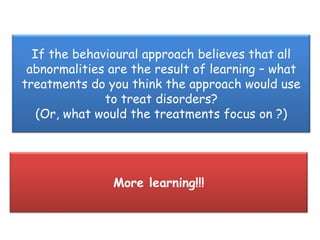Behavioural therapies
- 2. Quick recap of the behavioural approach – what can you remember? All behaviours are learnt Classical conditioning – learning through association Operant conditioning – learning through reinforcement Social Learning – vicarious learning (through others) Investigated using animal studies – issues with extrapolation
- 3. If the behavioural approach believes that all abnormalities are the result of learning – what treatments do you think the approach would use to treat disorders? (Or, what would the treatments focus on ?) More learning!!!
- 4. Systematic Desensitisation – how it works Used for phobias and OCD • Works on classical conditioning techniques • Changing previous learnt maladaptive responses with new more adaptive responses • Reciprocal inhibition • Counter-conditioning Someone with a fear of spiders will have learnt to feel afraid when there’s a spider present so the therapy systematically teaches the person a new response. The client is then taught deep relaxation techniques to use when a spider is present – enabling them to become desensitised to the spider
- 5. Systematic Desensitisation A hierarchy of fearful situations is created – each step being more fear- provoking than the last Client is taught deep relaxation techniques The client learns to associate the relaxation with the least fearful scenario Once that’s achieved the client is encouraged to systematically make step by step progress through the hierarchy
- 6. E.g. Of SD hierarchy
- 7. Systematic Desensitisation– is it any good as a treatment? Yes and no… + Barlow et al (2002) SD can be useful/effective for some phobias - Ethical issues - Ohman et al (1975) SD isn’t effective for complex phobias
- 8. SD is effective For example, Barlow et al (2002) found success rates of between 60-90% for specific phobias This is positive because the success of behavioural therapies means there’s no need for potentially damaging biological treatment (e.g. Drugs)
- 9. Ethical Issues For example, clients undergoing SD are exposed to their most feared scenario, potentially experiencing high stress This is a weakness because clients may not stay in therapy to reach ‘cure’ and may leave in a worse state than they entered
- 10. Not effective for complex phobias For example, Ohman et al (1975) suggested that SD isn’t effective in treating anxieties with an underlying survival component (e.g. Heights) A weakness because SD only focuses on removing symptoms rather than identifying the underlying cause of the disorder – meaning the effects of treatment by only be temporary









